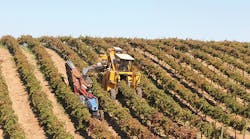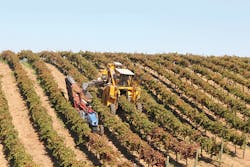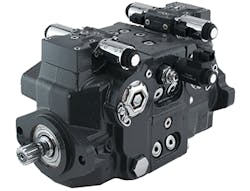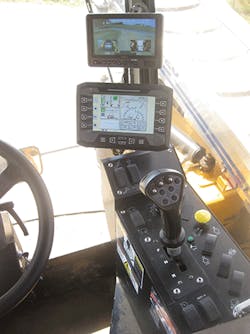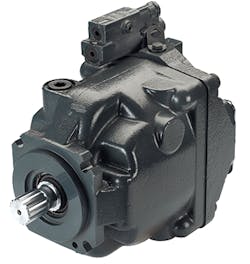Controls Squeeze Performance from Grape Harvesters
This file type includes high resolution graphics and schematics when applicable.
Industry standards for grape-harvesting equipment have changed dramatically over the centuries-long history of wine production. In many cases, technology has replaced manual harvesting, but steep, mountainous slopes, narrow rows of vines, and widely varying picking requirements continue to challenge engineers building today’s vineyard machinery.
One industry-leading manufacturer, Oxbo International, Lynden, Wash., draws on nearly 20 years of experience designing and developing advanced grape harvesters that tackle these unique conditions for international customers. The Oxbo 6000 line of grape and olive harvesters is its most advanced line of vineyard harvesters to date. This family of three four-wheeled machines leverages the latest advances in electronic-control technology and hydraulic solutions to ensure safe and efficient operation in demanding vineyard conditions.
Primarily used in the California grape industry, machines in the 6000 line are designed to operate in settings that range from hot, high-yield areas with wide 11-foot row spacing, and low-yield, sloping areas (sometimes 30% grade or steeper) with tight 6-ft row spacing.
Tom Vander Wilt, an Oxbo design engineer who has worked on the 6000 line since its inception, says, “There are so many different models required for different vineyard configurations that a major challenge was to create this family of machines that can use the same hydraulic, control, and basic frame systems.”
A successful harvester that operates in this range of circumstances needs hydraulic components that withstand heavy use and offer integrated electronic-control compatibility to ensure safe and efficient ground drive operation. Such components must also be flexible enough to adapt to specific customer needs and react to variable operating conditions.
Learning from the past
In 1998, Korvan, which would later become part of Oxbo International, built its first grape harvesters. The original three-wheeled model, the 3016, is still popular today, and the 6000 line models are built on the success and knowledge gained from this original machine.
The model 3016 used a manually controlled variable-displacement pump from Danfoss Power Solutions, Ames, Iowa, and analog controls. A joystick, switches, levers, and simple readouts were used to control and monitor the machine, requiring a great deal of operator involvement. Although this early machine performed well on hills and featured a particularly high-quality picking and cleaning mechanism, traction control was identified as an area that needed improvement.
The 3016 required splitter valves for traction control. These systems worked well when used for temporary traction needs, such as getting out of a patch of mud. But relying on these valves during the sustained vineyard inclines wasted power (fuel) and created heat that adversely affected the hydraulic system. Vehicle operators would manually destroke the front wheel motors when going uphill or the back wheel motors when going downhill to put them into high–speed, low-torque range.
After becoming part of Oxbo International in the mid 2000s and assessing the future of the machines, officials knew that vineyard managers expected more electronic-control options and more advanced traction control. By this time, competitive machines began to deliver both.
Developing a new hydraulic ground drive
The first step toward addressing concerns about traction control and electronic control was to overhaul the hydraulic ground drive for the 6000 line. After assessing the competitive market and considering customer performance and efficiency expectations, Oxbo, with help from Berendsen Fluid Power, Seattle, Wash., and Danfoss Power Solutions, began to overhaul its ground drive system, moving from a three- to four-wheel setup. However, making this happen wasn’t as easy as simply adding a second axis.
Vineyard harvesters feature a tall tunnel (about 7 ft.) and can range in width from 2.5 to 5.25 ft. through the middle of the machine, where collection, cleaning, and sorting mechanisms are housed. Operators must navigate safely and consistently through rows of vines at speeds ranging from 1 to 3 mph, making sure trellises holding the crop run through the harvester’s tunnel.
Owning to the design of the machine, each wheel is controlled by individual Danfoss M46 variable-displacement motors, with optional Danfoss H1 variable displacement motors for higher tractive effort. To configure these motors, Oxbo engineers specified a Danfoss tandem H1 53cc/53cc pump, with one half providing oil flow to the front wheel motors and the other controlling oil flow to the rear wheel motors. The remaining functions, such as steering, picking head, conveyor belts and cleaning fans, are controlled using an open-loop system powered by a Series 45 axial-piston pump.
Having worked with Danfoss components in the past, Oxbo engineers were familiar with their performance and came away impressed with their efficiency when testing the redesigned ground control system. In addition, the support and availability of Danfoss products meant Oxbo could have their machines ready for testing quickly, which shortens product-development cycles.
Integrating Plus+1 controls
After focusing on the hydraulic side and developing the new version of the ground drive system, Oxbo turned its attention to electronic-control options. Most Danfoss components are Plus+1-compliant, so the first version of this updated system used Danfoss Plus+1 electronics for automatic height control. Although this was just the beginning for this product line, Oxbo engineers continued to introduce additional electronic controls as they explored the capabilities of Plus+1.
With Danfoss Plus+1, engineers have the flexibility to develop software unique to their needs. Using Guide, a Plus+1 graphical software-development tool, developers don’t have to write code. Rather, they only need to drag and drop graphical components to come up with a representation of the control logic of the machine.
“Plus+1 enables engineers who understand how the machine should work to develop the machine’s software,” explained Christian Daley, Senior Systems and Application Engineer for Danfoss. “This can dramatically reduce the development time of new machines.”
Focusing on how performance might change during operation, such as when driving around corners or over hills, Oxbo engineers began to identify the necessary inputs to consider for maximum machine efficiency and performance. Once these were identified, Oxbo engineers developed a power-efficient operating system for the harvesters. The previous analog system limited the operators’ control over the harvester.
Benefits from upgrades
Implemented across the Oxbo fleet of vineyard harvesters, the current Plus+1-developed operating system gives the operator control over a much broader set of machine features, and takes some of the guesswork out of maximizing machine control for the most efficient operation. The Oxbo 6000 product line utilizes Danfoss electronic controls that include 50-pin controllers, I/O expanders, and a DP700 display, making machine control intuitive to the operator.
In today’s vineyard harvesters, the Plus+1-integrated hydraulic system offers control over end-user functions such as automatic height and leveling control, automatic picking head speed control, automatic steering control, and ground drive speed control. These capabilities are expected to expand.
In addition to the Plus+1 system’s end-user applications, the electronic controls also allow for more efficient and standardized production and service. The compatibility between the Danfoss hydraulic products, used in the ground drive and electronic-control systems, and Plus+1 programming environment enables “plug-and-play” production. Rather than create custom code for each machine, engineers can utilize the Plus+1 library of applications to draft and apply software across a wide range of harvesting vehicles. In addition, Plus+1 allows for automated calibration sequences that would otherwise be manual, variable, and incredibly time-consuming.
Oxbo’s Vander Wilt added, “To calibrate accurate wheel speeds manually, a technician must watch for wheel movement. Different people have different perceptions of what that movement looks like, and this can lead to inconsistent calibrations from machine to machine. Calibrating wheel speeds using the Plus+1 system allows consistently high performance across the fleet of machines.” This type of calibration is necessary for high-performance end-user operation.
Additional benefits
Service has also benefited from the implementation of the Plus+1 system. Berendsen and Danfoss were able to help with aspects of system design to simplify service, and due to the availability of Danfoss products, Oxbo can minimize harvester downtime. Even in the case of machine malfunction or breakdown, Plus+1-produced code automatically generates error codes, which helps more efficiently service or repair the harvesters.
From production to operation to repair, the integration of Plus+1 controls and hydraulic components in the Oxbo 6000 line of vineyard harvesters helps increase efficiency and reliability. The line has been in production since 2010, with the newest addition, the 6120, released in 2014.
This file type includes high resolution graphics and schematics when applicable.
Jeff Herrin is Vice President, Research & Development, Danfoss Power Solutions, Ames, Iowa. For more information, call (515) 239- 6000 or visit powersolutions.danfoss.com.
